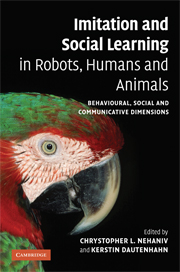 Imitation and Social Learning in Robots, Humans and Animals
Imitation and Social Learning in Robots, Humans and Animals Published online by Cambridge University Press: 10 December 2009
Introduction
Simulation theory
According to the simulation theory, ‘human beings are able to use the resources of their own minds to simulate the psychological etiology of the behaviour of others’, typically by making decisions within a ‘pretend context’ (Gordon, 1999). During observation of another agent's behaviour, the execution apparatus of the observer is taken ‘off-line’ and is used as a manipulable model of the observed behaviour.
From a roboticist's point of view, the fundamental characteristics of the simulation theory are:
Utilization of the same computational systems for a dual purpose; both behaviour generation as well as recognition.
Taking systems off-line (suspending their normal input/output) which necessitates a redirection and suppression of input (feeding ‘pretend states’ following a perspective taking process, suppressing the current ones that are coming from the visual sensors while this is performed) and output from/to the system to achieve this dual use.
Simulation theory is often set as a rival to the ‘theory-theory’, where a separate theoretical reasoning system is used; the observer perceives and reasons about the observed behaviour not by simulating it, but by utilizing a set of causal laws about behaviours.
It is important to note that in the experiments we describe here, ‘understanding’ the demonstrated behaviour equates to inferring its goal in terms of sensorimotor states, and does not imply inference of the emotional, motivational and intentional components of mental states.
To save this book to your Kindle, first ensure [email protected] is added to your Approved Personal Document E-mail List under your Personal Document Settings on the Manage Your Content and Devices page of your Amazon account. Then enter the ‘name’ part of your Kindle email address below. Find out more about saving to your Kindle.
Note you can select to save to either the @free.kindle.com or @kindle.com variations. ‘@free.kindle.com’ emails are free but can only be saved to your device when it is connected to wi-fi. ‘@kindle.com’ emails can be delivered even when you are not connected to wi-fi, but note that service fees apply.
Find out more about the Kindle Personal Document Service.
To save content items to your account, please confirm that you agree to abide by our usage policies. If this is the first time you use this feature, you will be asked to authorise Cambridge Core to connect with your account. Find out more about saving content to Dropbox.
To save content items to your account, please confirm that you agree to abide by our usage policies. If this is the first time you use this feature, you will be asked to authorise Cambridge Core to connect with your account. Find out more about saving content to Google Drive.